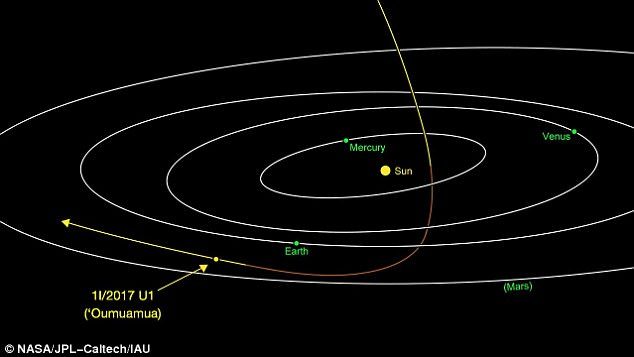
Astronomers who have been observing this first-ever confirmed interstellar visitor have named it Oumuamua, which in Hawaiian means a messenger from afar arriving first.
Scientists are certain this 600-foot-long, pale pink asteroid or comet originated outside our solar system.
'I'm surprised by the elongated shape - nobody expected that,' said astronomer David Jewitt of the University of California, Los Angeles, who led the observation team that reported on the characteristics.
First spotted last month by the Pan-STARRS telescope in Hawaii, it will stick around for another few years before departing our sun's neighborhood.
Jewitt and his international team observed the object for five nights in late October using the Nordic Optical Telescope in the Canary Islands and the Kitt Peak National Observatory near Tucson, Arizona.
At approximately 100 feet by 100 feet by 600 feet (30 meters buy 30 meters by 180 meters), the object has proportions roughly similar to a fire extinguisher - though not nearly as red, Jewitt said Thursday.
The slightly red hue - specifically pale pink - and varying brightness are remarkably similar to asteroids in our own solar system, he noted.
Astronomer Jayadev Rajagopal said in an email that it was exciting to point the Arizona telescope at such a tiny object 'which, for all we know, has been traveling through the vast emptiness of space for millions of years.'
'And then by luck passes close enough for me to be able to see it that night!'
The object is so faint and so fast - it's zooming through the solar system at 40,000 mph (64,000 kph) - it's unlikely amateur astronomers will see it.
In a paper to the Astrophysical Journal Letters, the scientists report that our solar system could be packed with 10,000 such interstellar travelers at any given time. It takes 10 years to cross our solar system, providing plenty of future viewing opportunities, the scientists said.
Trillions of objects from other star systems could have passed our way over the eons, according to Jewitt.
It suggests our solar system ejected its own share of asteroids and comets as the large outer planets - Jupiter, Saturn, Neptune - formed.
Why did it take so long to nail the first interstellar wanderer?
'Space is big and our eyes are weak,' Jewitt explained via email.
First spotted last month, it will stick around for another few years before departing our sun's neighborhood.
The International Astronomical Union, meanwhile, has approved a new designation for cosmic interlopers like this one.
They get an 'I' for interstellar in their string of letters and numbers.
The group has also approved a name for this object: Oumuamua, which in Hawaiian means a messenger from afar arriving first.
The comet, called C/2017 U1 was spotted by a telescope in Hawaii on 18 October, and was then seen 34 separate times in the week after.
While most comets follow ellipse-shaped orbits around the sun, this comet appears to orbit at an angle, and doesn't circle the sun.
Its orbital path suggests it entered our solar system from the direction of the constellation Lyra, looped around the sun, and will never return.
Rob Weryk, a postdoctoral researcher at the University of Hawaii Institute for Astronomy (IfA), was first to identify the moving object and submit it to the Minor Planet Center.
Weryk subsequently searched the Pan-STARRS image archive and found it also was in images taken the previous night, but was not initially identified by the moving object processing.
Weryk immediately realized this was an unusual object. 'Its motion could not be explained using either a normal solar system asteroid or comet orbit,' he said.
Weryk contacted IfA graduate Marco Micheli, who had the same realization using his own follow-up images taken at the European Space Agency's telescope on Tenerife in the Canary Islands.
But with the combined data, everything made sense. Said Weryk, 'This object came from outside our solar system.'
'This is the most extreme orbit I have ever seen,' said Davide Farnocchia, a scientist at NASA's Center for Near-Earth Object Studies (CNEOS) at the agency's Jet Propulsion Laboratory in Pasadena, California.
'It is going extremely fast and on such a trajectory that we can say with confidence that this object is on its way out of the solar system and not coming back.'
The CNEOS team plotted the object's current trajectory and even looked into its future.
A/2017 U1 came from the direction of the constellation Lyra, cruising through interstellar space at a brisk clip of 15.8 miles (25.5 kilometers) per second.
Observations published by the International Astronomical Union's Minor Planet Centre (MPC) suggest the comet likely escaped the orbit of another star.
The MPC said: 'Unless there are serious problems with much of the astrometry listed below, strongly hyperbolic orbits are the only viable solutions.
'If further observations confirm the unusual nature of this orbit, this object may be the first clear case of an interstellar comet.'
But not everyone is convinced that the comet comes from another solar system.
Dr Maria Womack, a planetary scientist at the University of South Florida said: 'It could have interacted with Jupiter or another planet in such a way that changed its orbit.
'When you think of photos of comets, they're a fuzzy blob. People have to make determinations of where they think the centre is.
'Someone who is at the telescope has to make a call.'
Astronomers now hope to continue tracking the comet to learn more about its origin.



Reader Comments